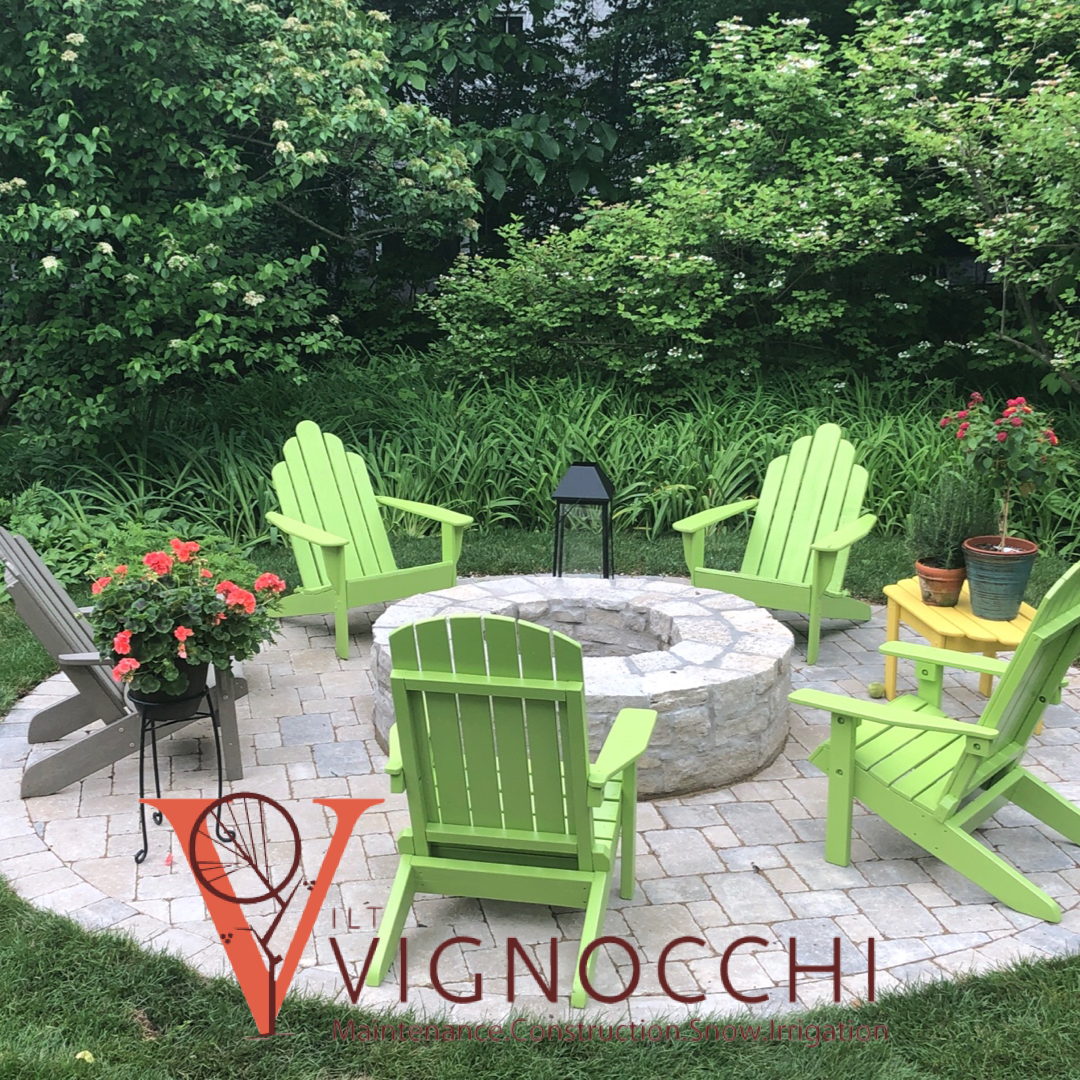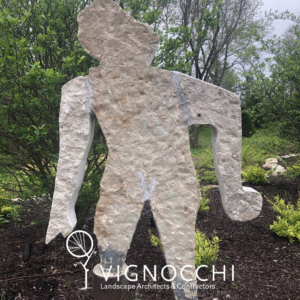Tag Archives: design ideas
Recently completed Fire Pit in Highland Park, IL

Artistry runs deep here
Suburban Sanctuary NEW You tube video
On a sprawling 3 acres in Itasca, Illinois this property includes several relaxing vignettes, a putting green and tennis court. Perfect for entertaining it also boasts a custom fireplace and spa.
You have GOT to see this!
Don’t forget to follow us on You Tube to stay up to date on all of our exciting drone videos!
New You Tube Video!!
Memories of rain and trains
This morning one of my two favorite moments happened simultaneously…laying in bed while it is still dark out listening to the rain and hearing the distant sound of a train’s horn. It might seem like a simple thing, but simple things can transport us back to simpler times.
The sound of a train blowing it’s horn in the early moments before daybreak bring me back to time spent at my mother’s family farm in Indiana. It conjures a picture in my mind of crisp red and white, an apple orchard, and my grandfather sitting alone in the kitchen before dawn with a cup of coffee, his profile illuminated by the small light on the kitchenstove.
My family is very proud of our small farm and their father, mother, brothers and sisters, who worked so hard to provide the necessities. You see, they were tied to the land. Growing to feed their families. They were prey to the same things we are prey to in our business…the weather, pests, disease, and ah yes…little critters.
I remember my grandfather had a book that outlined how and what he would plant each year, and how he intended to rotate those crops annually to get a better yield. Thinking back I wished I had had more interest, asked more questions. Maybe he had some secrets I could have used, not scientific research like we have abound today, but something he knew in his gut.
I was fortunate to have both sets of grandparents come from a place and time that held enormous respect for the land’s ability to provide beauty and sustenance. They only bought what they could not grow and they worked painstakingly hard for what they had to buy.
When my husband and I started a family, one of the first things we did was create a vegetable garden. I would constantly seek my mother and my grandmother’s advice. I would create a book, like my grandfather and make certain to rotate my crops. I made certain it was pretty as well. We also battled bunnies, pests, weather and disease. Although that garden fills me with immense satisfaction, joy and pride, it pales in comparison to the gardens of both of my grandparents and my mother’s.
But I do it, not just because it makes me think of my family, but because it reminds me and teaches my daughter…or as my mother says, “the land will always provide.”
Donna Vignocchi Zych
Benefits of Fall Planting
Most people think of fall as the end of the growing season and the beginning glimpse of another Chicago winter. Well try to look at it as an ideal time to plant!
Fall is a perfect time for planting shrubs, trees, grass seed, and even perennials if they have a developed root system. Fall planting gives plants time to develop roots before winter’s blustery conditions. The conditions are also less stressful and there may be more reliable precipitation.
What happens during fall conditions is a plant’s leaf and flower production is usually slowing down and approaching dormancy. Therefore, a plant can focus on root production. Roots continue to grow when other parts of the plant are not. Generally speaking, root systems will keep growing as long as the soil temperature is at least 50 degrees.
Although we generally get more rain in fall, the good news is that plants use less water then. Because days are increasingly shorter and cooler in the fall, plants are going to be photosynthesizing less and using less water.
Fall is also when depleted nurseries can begin to dig plants again, so varieties that were either unavailable or just downright unsightly in July and August, may become available.
Finally, don’t forget about BULBS! Its often surprising why more people don’t take advantage of this relatively inexpensive way to welcome in Spring. To achieve a gorgeous Spring show bulbs are planted in late fall.
If you’d like to start planning a fall project, it is right around the corner, so call us now and we will be happy to assist you!
Perfect Pansies
I have a deep love of pansies. I adore that they come in every color of the rainbow, which is unusual for an annual flower. It is wonderful that they can be pure, or blotched or multicolored all on the same plant. Have you ever looked at pansies when it is about to storm? Try it, they absolutely glow.
What really sets them apart though is how charming cheerful they are.
What can be seen as a drawback? They are a cool season plant and in the Midwest we only get to enjoy them in spring and fall. Oh I’ve done the experiments…transplanting them to the coolest shadiest parts of my yard to no avail. They just peter out. I actually like that they only shine twice a year. It makes them all the more special.
It is thought that pansies are a close cousins to the viola, which has roots in Greece in the 4th century B.C. However, they believe the first pansies were first found in France, because the word pansy is traced back to the French word pensee, meaning thought or remembrance.
In the early 1800’s an inquisitive Lord Gambier and his gardener William Thompson began experimenting with crossing different varieties of pansies. It is William Thompson who is accredited with removing long lines and created large blocks of color on the lower petals, created what is now known as “the face.”
Today popularity booms and most innovations are being made in Germany, Japan and the United States.
What is interesting is the amount of passion to innovate in this area. It isn’t to create a drought free plant, or even one that is resistant to diseases or animals (which they are NOT). The innovation, is to take something that was beautiful to begin with and make it even more so.
I for one am glad they are.
Donna Vignocchi Zych
President
Old Concepts, New Technology, Sustainable Results
Growing plants on rooftops is not a new concept. Centuries ago northern Scandinavians harvested sod from their surrounding landscape and placed it upon structures to create effective insulating and water resistant roof systems. The Vikings who explored the upper Atlantic built grass-covered homes where they settled and in Iceland sod roofs and walls have been used for hundreds of years.
Although the living roof or green roof has been in use for a long time, modern green roof technology has helped to elevate this building method from a crudely effective construction element to an aesthetically pleasing, ecologically responsible building solution for age-old building problems and current environmental concerns.
A green roof or living roof is a roof of a building or other structure that is partially or completely covered with vegetation and a growing medium, planted over a waterproofing membrane. It may also include additional layers such as a root barrier and drainage and irrigation systems.
Green roofs can be very basic, known as extensive green roofs that incorporate drought-tolerant, self-seeding native ground covers such as sedums, grasses, mosses and prairie flowers that require little or no irrigation, fertilization or maintenance. These green roofs are lightweight, inexpensive, and can be retrofitted onto existing buildings, often without significant alterations or additional structural support.
Intensive green roofs are more elaborate roof gardens designed for human interaction. They generally have a relatively flat roof surface or mild slope and allow for a larger selection of plants, including shrubs and trees and require specific engineering to be able to conform to the weight load requirements.
Today, the green roof is gaining in popularity as an environmentally conscious architectural expression that is a viable element of any sustainable landscape management plan; and here is why:
- Storm-water runoff will be greatly decreased with the utilization of a living roof. The growing medium and the vegetation of a green roof retain large amounts of storm water and release it back into the environment. A typical green roof can absorb 30% of the rainwater that falls on it, reducing the amount of water that goes through our waste water systems.
- It is a common misassumption that a green roof system will have a deleterious effect on the integrity of the roof system. Quite the opposite. A well designed, correctly installed green roof will protect the waterproof membrane that lies beneath it and, in turn, will extend the overall life of a roof. Recent studies indicate an increase in life span of almost double.
- Green roofs absorb carbon dioxide that contributes to global warming; and the slow transpiration of water back into the air creates a cooling effect that helps reduce the heat retention and emanation in and around your building.
- In addition to the energy saving features described above, the actual mass and density of a living roof will provide excellent sound insulation for a building as well.
- And let’s not forget the aesthetic benefits of the rooftop garden. The roof garden intermingles the pre-construction environment with the built environment creating a sustainable cooperation between development and nature. People love to interact in the relative secluded natural setting created by the intensive garden on a rooftop space. Additionally, they benefit emotionally and psychologically from the ability to even look upon the greenery of an intensive or an extensive roof top garden.
Green roof technology was re-invented in Germany in the mid-20th century and quickly spread throughout Europe mainly due to its restorative environmental impact.
Today, Chicago has been a leader in green roof installations with up to 7 million square feet on approximately 500 rooftops; the most of any city in the United States. The benefits of the green roof have not been ignored by suburban businesses and multi-family residential buildings either.
Corporations, commercial building owners, and homeowners associations are looking for solutions to increase employee well-being, decrease their carbon footprints, increase their LEEDS scores, and differentiate their properties from their competition. The rooftop garden has proven to be just such a solution.
Reach out to ILT Vignocchi today to inquire about the potential for your headquarters, office building, clubhouse, or other structure to benefit from a green roof installation.










